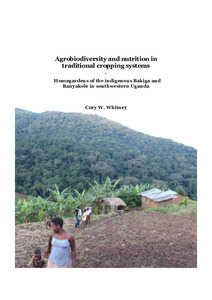| dc.date.accessioned | 2018-09-03T11:38:48Z | |
| dc.date.available | 2018-09-03T11:38:48Z | |
| dc.date.issued | 2018-09-03 | |
| dc.identifier.uri | urn:nbn:de:hebis:34-2018090356388 | |
| dc.identifier.uri | http://hdl.handle.net/123456789/2018090356388 | |
| dc.description.sponsorship | German Federal Ministry of Education and Research (BMBF) initiative "GlobE - Research for the Global Food Supply" | ger |
| dc.language.iso | eng | |
| dc.rights | Urheberrechtlich geschützt | |
| dc.rights.uri | https://rightsstatements.org/page/InC/1.0/ | |
| dc.subject | Food security | eng |
| dc.subject | Monte Carlo | eng |
| dc.subject | Anthropometry | eng |
| dc.subject | Plant species diversity | eng |
| dc.subject | HFIAS | eng |
| dc.subject | Anthropometry | eng |
| dc.subject | Dietary diversity | eng |
| dc.subject | HFIAS | eng |
| dc.subject | Plant species diversity | eng |
| dc.subject | Monte Carlo | eng |
| dc.subject | EVPI | eng |
| dc.subject | uncertainty | eng |
| dc.subject | cropping systems | eng |
| dc.subject | decision support | eng |
| dc.subject | probabilistic simulations | eng |
| dc.subject.ddc | 000 | |
| dc.subject.ddc | 390 | |
| dc.subject.ddc | 580 | |
| dc.subject.ddc | 630 | |
| dc.subject.ddc | 640 | |
| dc.title | Agrobiodiversity and nutrition in traditional cropping systems | eng |
| dc.type | Dissertation | |
| dcterms.abstract | In Uganda many farmer households have diverse agroforestry systems known as homegardens, which have been adapted over generations to supply a year-round harvest of nutritious foods. The work presented in this dissertation sought to identify the factors that influence the agrobiodiversity of these homegardens and to assess the effects of that agrobiodiversity on the health of the households that keep them. Households (n=102) were identified via stratified, random selection across three distinct regional ecological zones of southwestern Uganda (forest-edge, deforested areas, and wetland-edge). Their homegardens contained 209 (mean 26.8 per homegarden) useful crop species (excluding weeds and ornamentals). Crop diversity response variables regressed against socio-economic and bio-physical predictor variables, indicated weak but significant relationships (Adjusted R2 between 12 to 42%, p<0.001), the significant predictors included elevation, location, garden size, distance to market, additional land ownership (beyond the homegarden) and livestock ownership. Elevation, location and garden size also differed between four garden types, identified by cluster analysis (39 ‘Diverse tree gardens’, 10 ‘Small forest-edge gardens’, 10 ‘Large, old, species-rich gardens’, and 43 ‘Large, annual-dominated herb gardens’). Further agrobiodiversity studies with quantitative ethnobotany of 225 useful plant species (including ornamentals and weeds with secondary uses) revealed 3,961 use reports, 54% for food, 15% for economic uses and 11% for medicine. During related surveys of flora throughout the country, the baobab (Adansonia digitata L.) was recorded in a homegarden in the east, changing the current scientific knowledge of homegarden agrobiodiversity in Uganda.
The agrobiodiversity data from homegardens in southwestern Uganda were compared with multiple- pass 24-hour recalls, anthropometric measurements and food insecurity questionnaires of households (n=589, 325 and 95 respectively). Results indicated positive relationships between homegarden agrobiodiversity and health outcomes. Regression models explained between 16 and 50% of variance in dietary diversity and between 21 and 75% in anthropometric measurements.
Probabilistic Monte Carlo analysis was used to predict the nutrition implications of the country’s development plan to industrialize agriculture, versus maintaining homegardens. Results revealed that industrial farms produce more carbohydrate-based food energy, but that homegardens produce more key vitamins and micronutrients.
The holistic and uncertainty-embracing approaches presented in this dissertation should be used to inform agricultural development decisions, especially given the data scarcity in East Africa. | eng |
| dcterms.accessRights | open access | |
| dcterms.alternative | Homegardens of the indigenous Bakiga and Banyakole in southwestern Uganda | eng |
| dcterms.creator | Whitney, Cory W. | |
| dc.contributor.corporatename | Kassel, Universität Kassel, Fachbereich Ökologische Agrarwissenschaften | |
| dc.contributor.referee | Hensel, Oliver (Prof. Dr.) | |
| dc.contributor.referee | Gebauer, Jens (Prof. Dr.) | |
| dc.description.everything | This work would not have been possible without the financial support of the German Federal Ministry of Education and Research (BMBF) initiative "GlobE - Research for the Global Food Supply". Dr. Joseph Bahati facilitated the support of the Ugandan National Science Foundation, the office of President and the approval of the local Regional District Coordinators and Chief Administrative Officers of Bushenyi, Rubirizi, and Sheema, Uganda. During the fieldwork, Antonia Nyamukuru and Carolyne Nakaketo helped with interpretation and facilitation, and the Local Chairmen, other village members, and respondents welcomed us to their homes and farms and offered their support, hospitality and company. | eng |
| dc.subject.msc | 65C05 | ger |
| dc.subject.msc | 78M31 | ger |
| dc.subject.msc | 62J86 | ger |
| dc.subject.msc | 91C20 | ger |
| dc.subject.msc | 62H30 | ger |
| dc.subject.pacs | 02.70.Uu | ger |
| dc.subject.pacs | 02.50.Ng | ger |
| dc.subject.pacs | 02.60.Ed | ger |
| dc.subject.swd | Uganda | ger |
| dc.subject.swd | Nutzgarten | ger |
| dc.subject.swd | Artenreichtum | ger |
| dc.subject.swd | Biodiversität | ger |
| dc.date.examination | 2018-07-10 | |

